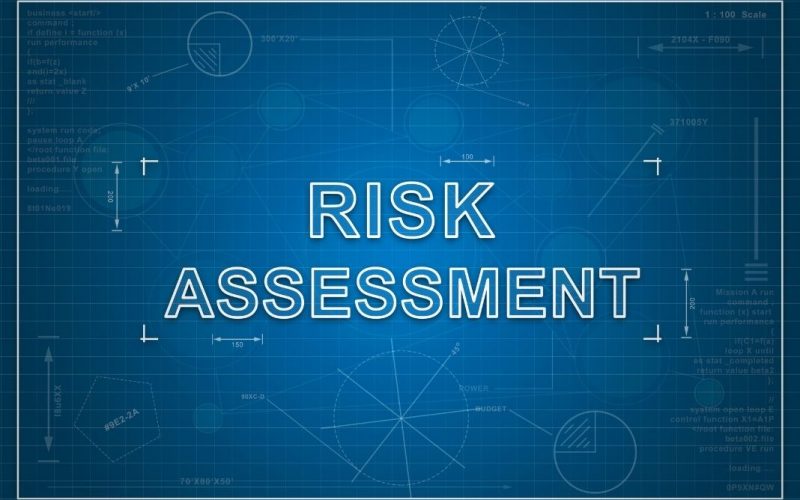Risk assessment is a major management strategy for ensuring worker health and safety (and others). What many people may not realize is that they are a legal obligation for businesses and certain self-employed people. Whether you’re wondering how to conduct a risk assessment or if they’re useful in your business, keep reading to learn the process of risk assessment.
What is a Risk Assessment?
Risk assessment is the methodical process of detecting hazards and analyzing any related risks in the workplace, followed by the implementation of appropriate control measures to remove or decrease them.
When doing a risk assessment, it is critical to specify the following terms:
- An accident is defined as “an unintended event that results in loss.”
- A danger is defined as “anything that has the potential to do harm.”
- A risk is defined as ‘the likelihood and severity of a negative occurrence (injury, ill-health, damage, or loss) as a result of a hazard.’
Additional training may be required if you need to finish or re-evaluate your risk management practices.
Different Methods of Risk Assessment
Any risk assessment necessary in the workplace should be proportionate and relevant to the operational tasks. Many sectors have unique legislative criteria that one must meet. In workplaces where hazardous substances are utilized, for example, a Control of Substances Hazardous to Health Assessment (COSHH) should be undertaken.
Some examples of frequent forms of risk assessments are:
- Fire risk assessments: Fire safety management processes, including a proper and sufficient fire risk assessment, must be developed in all workplaces.
- Manual handling risk assessments: You should carry this out in any workplace where an individual may be at risk of injury or illness due to the requirement to lift, carry, or transfer loads.
- Display screen equipment (DSE) risk assessment: You are to conduct this in workplaces where employees (and others) use computers, laptops, etc.
- COSHH risk assessments: you need them in workplaces where hazardous compounds are stored, used, or manufactured.
Depending on the nature of the operations, a company may also choose to create a Risk Assessment Method Statement (RAMS). This process includes information about the danger as well as a step-by-step strategy for completing the work and appropriately controlling the risks indicated. One uses this risk assessment process extensively in the building business.
Why are Risk Assessments necessary?
As previously said, conducting appropriate and sufficient risk assessments is one of the fundamental management tools ineffective risk management. It is a legal requirement for any employer and must be documented anywhere five or more individuals are employed.
Risk assessment is a basic and methodical approach to ensuring that hazards to employees’ (and others’) health, safety, and well-being are appropriately removed, reduced, or controlled.
The following are the primary goals of risk assessments:
- Identifying health and safety issues and assessing the risks in the workplace
- Assessing the efficacy and applicability of existing control measures
- To ensure that additional controls (including procedural controls) are introduced if the residual risk is deemed to be anything other than low.
- To prioritise additional resources as needed to ensure the above.
If a company does not have the required controls in place, it can be a costly lesson. They could face not only financial loss (through fines, civil proceedings, and so on), but also loss in terms of production time, equipment damage, time to train new staff, and unfavorable publicity, among other things.
According to a recent article in BSC Safety Management magazine, a corporation was fined £274,000 after two workers became stuck in moving machinery in two separate incidents. In the report, Health and Safety Executive (HSE) inspector Saffron Turnell stated that “companies should be aware that HSE would not hesitate to take enforcement action against those who fall below the acceptable standards.” Cases like this one should serve as a wake-up call to all businesses, highlighting the need for risk assessments.
Read Also: Strategic Risk Management: Overview, Plans, Implementation (+ Free tips)
Who is in charge of carrying out Risk Assessments?
It is the employer’s (or self-employed person’s) obligation to conduct a risk assessment at work or to appoint someone with the necessary knowledge, experience, and abilities to do so.
According to the Management of Health and Safety at Work Regulations 1999, an employer must take reasonable steps “for the effective planning, organization, control, monitoring, and review of preventative and protective measures.” So, even if the duty of risk management is delegated, it is ultimately the responsibility of management in every firm to guarantee that it is accomplished properly.
Once hazards have been identified, related risks evaluated, and steps made to mitigate potential consequences, the next stage for an employer is to clearly and effectively communicate the risk assessment process and content to appropriate stakeholders.
Communication is more effective when all relevant parties are included in the risk assessment process at all stages. The individual doing an activity or task is frequently in the best position to provide specifics on the relevant hazards and risks. They should fully engage in the risk assessment.
Read Also: Risk Mitigation Strategies: Four Common Strategies with Examples.
When should You Conduct a Risk Assessment?
Prior to carrying out a specific activity or task, you must conduct a proper and sufficient risk assessment. This helps to eliminate, diminish, or suitably control any related risk to the health, safety, and well-being of those participating with (or impacted by) the task/activity in question.
Once completed, a risk assessment should be evaluated on a regular basis (proportionate to the amount of risk involved). So, in any case when the existing assessment is no longer valid and/or if there have been significant modifications to the specific activity or task at any point.
Following an accident, incident, or illness event, relevant risk assessments should be reviewed to see whether the control measures and level of evaluated risk are suitable or need to be amended.
How can I Conduct a Risk Assessment?
The HSE has recommended a five-step process for performing a risk assessment. This provides a useful checklist to ensure that the assessment is sufficiently detailed. It includes the following steps:
- Identifying possible threats
- determining who might be harmed by those hazards
- Assessing risk (severity and likelihood) and putting appropriate safeguards in place
- Implementing controls and documenting your results
- Examining your assessment and, if necessary, re-evaluating it.
Step 1: Identify potential hazards.
It is critical to first identify any potential risks in the workplace that may cause injury to anyone who comes into contact with them. They may not always be visible, so here are some easy actions you may take to identify hazards:
- Observation: Walkabout your workplace and search for activities, jobs, processes, or substances that could endanger your staff (or others)
- Examining previous accidents and ill-health records, as they may reveal less visible hazards
- Examining data sheets, instructions, information, and guidance provided by manufacturers
- Consultation with employees (and others) who are carrying out the activities, tasks, or procedures
It may be useful to categorize dangers into five categories: physical, chemical, biological, ergonomic, and psychological.
Step 2: Determine who may be injured by the hazards.
Next, determine who might be harmed by those possible hazards. It should also be noted how they might be affected, whether by direct or indirect interaction. It is not required to mention people by name, but rather by identifying groups such as:
- Employees
- Contractors
Certain risks may provide a greater risk to specific groups, such as children, adolescents, new or expecting moms, new employees, home workers, and lone workers.
Step 3: Determine the severity of the risk and put measures in place.
After identifying any hazards and who might be affected, it is critical to assess the severity of the risk (should it occur) and implement appropriate and effective controls to decrease this level of risk as far as is ‘reasonably practicable. This means that everything feasible is done to protect health and safety while taking into account all essential elements such as:
- Possibility of injury
- The severity of the injury that may occur
- Understanding of how to eliminate, reduce, or control hazards and risks
- Availability of control methods aimed to eliminate, decrease, or appropriately control the risk
- Costs associated with available risk-reduction techniques aimed to eliminate, decrease, or control the risk.
Assessing the severity of risk necessitates an assessment of the likelihood of an occurrence as well as the magnitude of the consequences that may result. Some of the criteria influencing this rating are the duration and frequency of exposure, the number of people affected, the competency of individuals exposed, the type of equipment and its condition, and the availability of first-aid and/or emergency support.
Step 4: Put the adjustments into action and document your findings.
Significance findings of risk assessments must be kept either electronically or in writing if a workplace has five or more employees. Keeping track of the hazards and control measures put in place to mitigate the identified risk is as simple as recording your results on a risk assessment form. The form comprises the following items:
- What dangers were discovered?
- Affected individual(s) or group(s)
- The risk management mechanisms in place, as well as who is monitoring them
- Who conducted the assessment?
- When was the assessment performed?
It is prudent to ensure that the risk assessment is proportionate to the activity or task being performed. This is frequently a simple process for basic operations.
Step 5: Go over your assessment again and reassess if required.
Employers should revisit the assessment on a regular basis and, if necessary, re-evaluate any controls in place.
The following are some guidelines for when you should assess your processes:
- After any significant changes to the workplace or process in question
- Following an accident or a health-related incident
- Following reports of near-misses.
What kind of Paperwork do you require?
It is a common misperception that risk assessments necessitate a large amount of documentation. It might be as simple as filling out a basic risk assessment form for numerous typical operations or activities.
Employers, on the other hand, should ensure that major discoveries are documented, such as:
- Any dangers discovered
- What controls are presently in place, as well as information on any further controls that may be required
- Individuals who have been identified as being extremely vulnerable.
There is no specified period of time in which you must preserve the risk assessment. However, it’s best practice to keep it for as long as it’s judged relevant to a certain task or activity.
Risk assessments are an essential aspect of maintaining everyone’s health, safety, and well-being in the workplace.






